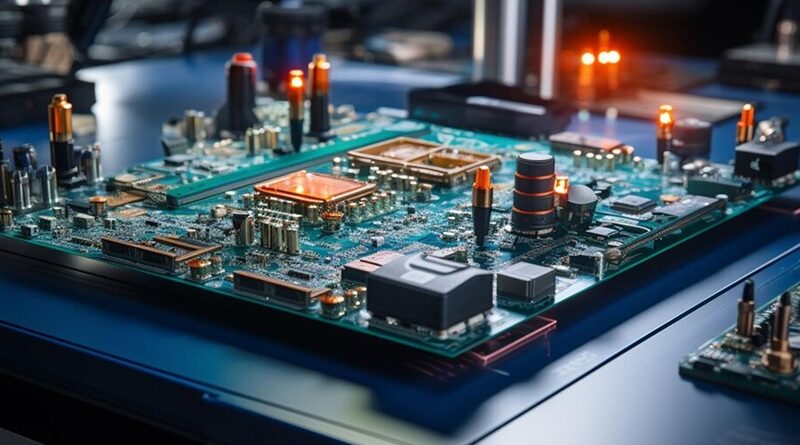Maximizing Thermal Efficiency: The Role of Heat Sink PCBs in Compact Electronics
Continuous operation of circuits in devices generates heat, posing risks such as overheating and potential damage. Proper heat dissipation and ventilation are crucial, extending to printed circuit boards. Thermal management, integral to PCB manufacturing and PCB assembly, ensures that electronic components stay within safe temperature ranges. Understanding thermal management is paramount for designers, optimizing product performance and minimizing failure risks.
Introduction:
Heat dissipation is a critical aspect of electronic design, particularly in compact and high-performance devices. Printed Circuit Boards (PCBs) play a crucial role in managing thermal issues, with heat sink PCBs emerging as an effective solution for efficient heat dissipation. In this article, we’ll explore the significance of heat sink PCBs, their mechanics, applications, and benefits in compact electronics, highlighting their role in maximizing thermal efficiency and ensuring reliable performance in demanding environments.
Understanding Heat Sink PCBs:
Heat sink PCBs are specialized circuit boards designed to enhance thermal management in electronic devices. By incorporating heat-dissipating elements directly into the PCB substrate, these boards efficiently dissipate heat generated by electronic components, ensuring optimal operating temperatures and extending the lifespan of critical components.
Heat Sink PCBs, also known as Thermal Management PCBs, integrate heat dissipation functionality directly into the circuit board design. By leveraging advanced materials and engineering techniques, these PCBs efficiently dissipate heat generated by electronic components, ensuring optimal operating temperatures and prolonging the lifespan of the device.
Key Elements and Functions:
Heat sink PCBs consist of several crucial elements that contribute to their thermal performance:
Metal Core : The structural backbone of the PCB, providing a robust platform for heat dissipation.
Thermal Vias : Microscopic channels that facilitate the transfer of heat from components to the metal core.
Copper Layers : Conductive layers that disperse heat and facilitate electrical connectivity within the board.
Types of Heat Sink PCBs:
Heat sink PCBs are categorized into passive and active types, each offering distinct advantages based on thermal requirements and application needs.
Passive Heat Sink PCBs : Rely on natural convection and conduction for heat dissipation, making them suitable for moderate heat loads and cost-effective solutions. Aluminium-based and copper-based heat sinks are commonly used in passive configurations, with aluminium offering affordability and copper providing superior thermal conductivity.
Active Heat Sink PCBs : Incorporate additional components such as thermoelectric coolers (TECs) or liquid cooling systems for forced heat dissipation. TECs utilize the Peltier effect to actively remove heat from components, while liquid cooling systems circulate coolant through micro channels to dissipate heat more efficiently.
Benefits and Applications:
Heat sink PCBs are gaining popularity in various industries due to their numerous benefits:
Compact Design : Ideal for space-constrained applications, heat sink PCBs allow for efficient heat dissipation without requiring additional bulky heat sinks.
Enhanced Thermal Performance : By directly integrating heat-dissipating elements into the PCB substrate, these boards offer superior thermal conductivity and heat dissipation capabilities.
Improved Reliability : By maintaining optimal operating temperatures for electronic components, heat sink PCBs enhance reliability and longevity, reducing the risk of premature component failure.
Versatile Applications : From consumer electronics to industrial machinery, heat sink PCBs find applications in diverse industries where efficient thermal management is critical for performance and reliability.
One of the primary advantages of Heat Sink PCBs is their compact footprint, which aligns seamlessly with the space constraints of modern electronics. Traditional heat sink solutions often require additional space and assembly steps, increasing complexity and manufacturing costs. In contrast, Heat Sink PCBs integrate thermal management directly into the circuitry, minimizing footprint while maximizing efficiency.
Moreover, Heat Sink PCBs offer versatility in design, allowing for customized thermal solutions tailored to specific applications. Engineers can optimize the layout and configuration of heat dissipation elements, such as thermal vias, copper traces, and heat sinks, to suit the thermal requirements of the device. This flexibility ensures efficient heat transfer away from critical components, mitigating the risk of overheating and performance degradation.
In addition to their thermal benefits, Heat Sink PCBs contribute to improved reliability and longevity of electronic devices. By maintaining optimal operating temperatures, these PCBs reduce thermal stress on components, preventing premature failure and enhancing overall system reliability. This is particularly crucial in mission-critical applications where downtime is not an option.
Furthermore, Heat Sink PCBs support advancements in miniaturization and form factor reduction without compromising performance. As electronics continue to shrink in size, the demand for efficient thermal management solutions becomes more pronounced. Heat Sink PCBs address this need by providing a compact and integrated approach to heat dissipation, enabling the development of sleeker and more powerful devices.
In conclusion, heat sink PCBs are indispensable components in modern electronics, offering efficient thermal management solutions for compact and high-performance devices. At PCB Power, we specialize in designing and manufacturing heat sink PCBs tailored to the unique thermal requirements of each application. Contact us today to learn more about how our advanced solutions can optimize thermal performance and reliability in your electronic designs.



